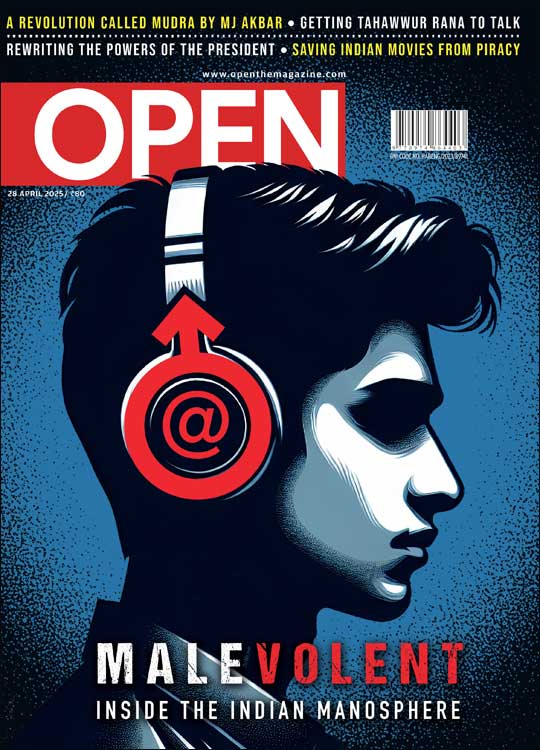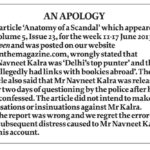The Man Authorities Came to Frame
The untold story of Anand Jon, a designer of Indian origin who has been sentenced to 59 years of imprisonment in the US on multiple counts of sexual misconduct, including rape. Guilty as charged? Or a victim himself? As he approaches re-trial, a close look at the case
 Mihir Srivastava
Mihir Srivastava
 Mihir Srivastava
|
12 Feb, 2012
Mihir Srivastava
|
12 Feb, 2012
/wp-content/uploads/2015/11/jon.jpg)
The untold story of Anand Jon. Guilty as charged? Or a victim himself? As he approaches re-trial, a close look at the case
Anand Jon’s cards were marked in advance. The trial was something of a peg circus, and if he had any chance at all, the American media was hellbent on closing it. To them, he was a ‘fashion designer turned serial rapist’, as they labelled him on his 2008 conviction of the rape of Jessie Marie B, among other violations of the law.
Few cared about details of the case. Jessie’s medical examination had revealed ‘no signs of trauma, injuries, use of force or assault related [suffering]’, as verified by the prosecution’s own expert witness Dr Schulman. Detected instead were signs of marijuana Jessie had smoked. Jon, the accused, had also undergone a lie detector test and passed, while the victim, Jessie, refused to take the test.
There was also evidence that Jon had been in a consensual relationship of some intimacy with Jessie. ‘Hi Babe. Miss You. Can’t wait to see you, xoxo,’ she had emailed Jon just hours before the alleged assault at his Beverly Hills flat in Los Angeles on the night of 4 March 2007. The next morning, she went to the police and charged him with rape, describing her relationship with Jon as ‘strictly professional’ in a written statement. ‘I thought it was cool, I was getting to model his clothes… I was confused. It still had not come to me what had happened,’ she stated nine hours after the violation.
At the trial in Los Angeles, Jessie described Jon’s apartment as “filthy”, “disgusting” and “gross”, with cockroaches on the floor. “The garbage was filled with tampons, and there were bras and bottles in the shower.” But in the CCTV footage of her walking in and out of the elevator on 5 March, talking on her phone, she did not seem terribly unsettled either by the assault or the filth.
Back at the flat, Jessie had been “in a happy and giddy mood” by the deposition of the two flatmates present, Holly Gavel and Lori B. “Never saw or heard any girl scream or act upset—or any illegal substances,” Lori B testified under oath.
As a key witness, she had had a long chat with the police soon after Jon was arrested. At the time, she made no allegation against him. After all, she was a friend. Later, Lori B even joined a ‘Support Anand Jon’ walk. However, just two days after that 15 September 2010 rally, she appeared before a grand jury accusing Jon of sexually assaulting her too.
That Anand Jon was quite the ladies’ man was never in doubt. He was popular with girls even during his college days in Chennai. He went to the US as a teenager in the early 1990s and graduated from New York’s Parson’s School of Design. As a professional looking to make it big in the land of opportunity, the zips seemed a decade made especially for him. An outgoing designer with undeniable talent, he took the US fashion scene by storm. He soon had clients like Paris Hilton, Oprah Winfrey and Janet Jackson, appeared regularly on VH1, E! and MTV, and got to share space with the likes of Obama on Newsweek’s list of ‘Who’s Next in 2007’.
Eleven seasons down, he was on a roll, with glamorous women hovering all around him. His was an unremarkable lifestyle for a fashion designer. But the prosecution saw a sinister design in it. Jon, they alleged, would lure young—often underaged—women to his New York and Beverly Hills studio apartment via the internet, and would indulge in ‘pre-pubescent child porn’.
Before Jon knew it, he was facing attacks on his truthfulness (or lack thereof), looks, talent, hygiene standards and what have you, not to mention slurs like ‘India head’ and ‘curry smelling dick’. “In March 2007,” Jon later said, “I found out what it means to be brown in the USA. I was called a brown ‘nigger’.” He and his family also received death threats.
Jon wasn’t just brown, he was a brown success. In fact, he was to sign a funding deal with a Wall Street firm for his line of denim jeans on 7 March 2007, a day after he was arrested on charges of ‘violent crimes’, ‘child abuse’ and ‘illegal drug use’. To his shock, he found himself accused of sexual misconduct by several women. The district attorney of LA had complaints on 59 counts, involving 20 women, levelled against him—later reduced to 23 counts and nine accusers, including Holly Gavel and Lori B. It was enough to put him away for a lifetime.
To those appalled by his alleged crimes, it was justice. To unconvinced observers, the case bore the stench of racial bias, sleaze, conspiracy, prosecutorial misconduct, selective use (and misuse) of evidence and worse.
Jon had to fire his team of defence lawyers once he realised that they were hand-in-glove with the prosecution. He argued his case alone. And lost.
The designer has filed an appeal since. He has a new defence team, which has filed its opening brief, to which the Attorney General of California has responded. The new trial will begin soon.
The first Los Angeles trial was seriously flawed, say those sympathetic to Jon. Many of the prosecution’s witnesses lied under oath, they say, and defence witnesses were coaxed by the Los Angeles County District Attorney (LADA) to switch sides. One of them testified in court to being ‘intimidated’ by the LADA’s lead prosecutor.
Much evidence went missing. About 2,000 documents, numerous video tapes and extensive online messages vanished during the investigation, which was flaky to begin with. Records of inconsistencies in statements made by witnesses and of acts on their part that could lower their credibility were either withheld or not thought worth preserving.
Detective Elwell, a police officer involved in the investigation, was forced to admit in court that he advised and instructed most of these women “to hold off on civil suits and anything like that until after the criminal case was done”. This officer, as per court records, was once pulled up for illegally retrieving privileged attorney-client information by hacking a computer of the defence. In Jon’s case, Elwell admitted that he had destroyed evidence and turned witnesses hostile—because he “did not want to complicate the case,” as he claimed.
Jon’s defence team was of no help. The loyalty of Donald Marks, one of his lawyers, was thrown into doubt when the lawyer’s daughter Elizabeth Roos took a job at the DA’s office during the trial. Another defence lawyer allegedly had an illicit sexual relationship with a key witness. After sacking them, he argued that he was a victim of manufactured evidence and witness manipulation. His personal computer, for example, had been fiddled with; it had recorded nine hours of usage after its seizure. The lead detective conceded that email evidence had been deleted—a blatant cybercrime committed by the cops. But Jon’s defence got him nowhere.
The jury found merit in such flimsy charges as Count 56: ‘attempted kiss’. So a failed bid to kiss a woman secured Jon seven of his 59 years in jail. Among other crimes, he was also held guilty of ‘touching while dressing’ a victim. Fashion designers would vouch for the fact that there is no known way to dress a model without touching her.
Just who were all these victims who kept tumbling out of one closet after another, these ‘innocent white girls’ who Jon had supposedly ‘preyed’ upon? According to the prosecution, they were naïve girls from small-town America. What is left unexplained is why they visited Jon so often, and why some of them were still doing so for years after they were allegedly molested.
The truth is that most were hookers, strippers and S&M bondage models, all known to one another and from such small-towns as—ahem—New York City, Los Angeles, Dallas, Houston, Santa Barbara and Philadelphia. This is not to imply that girls who pursue such professions cannot be victims of rape. But this does blow holes in the prosecution’s assertion that “none of these women even had any contact with each other” and that they had no plausible “motive” to frame Jon on false charges (‘I wanna sue him for all the money’ is part of Lori B’s written statement).
One of the charges levelled against Jon was that of ‘child pornography’ with 17-year-old Amanda Coulter (who lied that she’s 18 to Jon) as the victim. Jon touched her inappropriately, she told the court, and she was too afraid to resist his advances. But Jon’s home surveillance system, which captured the episode, has no sign of any coercion. What exist as evidence are a set of lewd images—dressed in lingerie, her breasts in focus—that she had emailed Jon. Even by the standards of an industry not known for demure day-to-day conduct, it is not clear how this could’ve been part of a ‘strictly professional’ relationship with him, as she claimed she had.
One charge Jon was found ‘not guilty’ of, to his relief, was that of unlawful sexual intercourse with one Britny O, a 17-year-old who was exposed during the trial as someone trying to blackmail Jon. A successful fashion designer, she had perhaps assumed, would be filthy rich. And a non-White one, an easy target.
Freedom in the land of the free, as Jon found to his dismay, can be awfully expensive. Soon after his arrest in March 2007, Jon did get bail as part of the due process of law. However, it was not the sort of money even a well-off designer could cough up rightaway. His bail was set at a steep $1.36 million.
But that was not all. Since there were multiple cases against him, he got trapped in what legal eagles often call ‘bail gridlock’. Over the next three months, he was asked to furnish an additional $300,000 for a bail bond in Dallas plus $1 million per accuser in Houston. In all, his tentative freedom (until a trial verdict) would have cost him as much as $10 million. Even that would not have been enough, for New York flatly denied him bail. Not only was Jon hauled back to the lock-up within a few weeks of being let out on bail in Los Angeles, he lost his $1.36 million as well.
Jon was not a man without enemies. He had a particularly bitter falling out with Patrick Fioriglio, a business partner (and now a witness against Jon) who he’d ejected as a director of his company in early 2007. Fioriglio had tried to take over Jon’s Jeanisis brand, reportedly valued at a few million dollars by Wall Street types at the time.
Now, Fioriglio happened to be close to Jon’s flatmates Holly Gravel and Lori B, who deposed against him after the second grand jury was constituted (in 2009). Lori B, who is reported to have committed perjury 26 times, has since turned out to be a common link between most of the girls who accused Jon of sexual misconduct (there’s evidence of their being in regular touch via email and phone).
And then there are Holly’s charges. Her own phone records show that she was in New Jersey and not in New York at the time she alleges Jon ‘drugged’ and ‘attacked’ her. This is a girl who had travelled with Jon and his family to places like Las Vegas and India, and had moved in with him, paying a monthly $900 as her share of the rent. She continued to live with him for a year after his alleged attack. “He was charming and I was impressed… [he] was kind and like a good friend, not a threat. He taught me how to do ab crunches,” she was reported to have said, of their time together, before she changed her story.
What Holly said in court lacked such credibility that the LA prosecutor, in his closing statement, told the jury to disregard her testimony. Holly appears on Fioriglio’s MySpace profile as one of his four friends in LA, all of whom are on the list of Jon’s accusers. One of these friends, Candace Mattocks, a 22-year-old Houston girl, met Jon on an 18+ dating site and flew to LA to be with him. She knew Fioriglio, but could not recollect his name, calling him a ‘Vin Diesel look-alike’ who pushed her to file charges against Jon, as she later admitted in court.
Then there was Katie Schwab from Dallas, who, after four-and-a-half years of keeping mum, charged Jon with touching her thigh at a restaurant and sexual misbehaviour while adjusting her dress.
Another victim, Tara Strogov from New Jersey, who would make sneak trips to Jon’s New York studio flat to spend time with him, claimed she was misled by his sexuality. “I went in his bedroom, got naked, and laid in his bed with him,” she said, “because I thought he was gay; he was very effeminate.”
As everyone in America’s world of glamour knows, gayhood has its own set of behavioural limits. Appearing on E!’s Golden Globes show in 2006, gay designer Isaac Mizrahi groped Scarlett Johansson’s breast, peeped down Teri Hatcher’s dress, quizzed Eva Longoria on her pubic hair, and asked others whether or not they were wearing underwear. All this was seen as the harmless buffoonery of a much-loved gay designer. Jon, however, was soon to be seen as a dangerous sexual predator.
Back in India, Jon’s mother Shashi and sister Sanjana are in trauma. Shashi, who raised them as a single-mother in Kerala, now lives in Gurgaon with Sanjana, a designer of some repute herself. They are in desperate need of funds to fight what is likely to be a long legal battle in the US.
Open’s visit finds Shashi morosely watching TV in her sitting room, with all the furniture pushed to the walls—on which hang photos of Jon in a loose collage. Sanjana sits sullen on a mattress on the floor.
Jon hasn’t been well. He is only 38 years old, but has a kidney stone. It’s induced by stress, his mother and sister feel, afraid that his condition will get neglected.
They have given up expecting the Indian Government to take up the case, but are investing more and more hope in divine intervention to compensate for that. Every Tuesday, Sanjana distributes sweets to the poor at Rajiv Chowk’s Hanuman Temple in Delhi. Every Thursday, she keeps an appointment with Sai Baba at the Lodhi Road temple.
Sanjana has an air of resignation about her. “The great American dream turned out to be a great American nightmare for us,” she says. When her brother got bail in 2007 and was free for a few months, friends had urged him to leave the US as quickly as he could (he had his passport with him), but he insisted he had faith in American fairplay and justice. It was a grievous mistake, she feels.
“I just want people to look at the facts,” says Sanjana, her voice quavering, “Is this asking for too much?”
She breaks into tears.

/wp-content/uploads/2025/04/Cover-Manosphere.jpg)











More Columns
Security forces surround one of the last bastions of Maoists Open
Hold the Mayo V Shoba
The Pahalgam Attack: Pakistan’s bid to distract attention from troubles at home Saleem Pandit